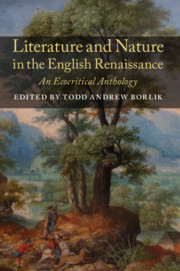Book contents
- Frontmatter
- Contents
- List of Illustrations
- Acknowledgements
- Editorial Principles: Towards the Ecocritical Editing of Renaissance Texts
- Introduction
- PART I Cosmologies
- PART II The Tangled Chain
- Hierarchy and the Human Animal
- Beasts
- Birds
- Fish
- Insects
- Plants
- Gems, Metals, Elements, Atoms
- PART III Time and Place
- PART IV Interactions
- PART V Environmental Problems in Early Modern England
- PART VI Disaster and Resilience in the Little Ice Age
- Appendix A Industrialization and Environmental Legislation in the Early Anthropocene: A Timeline
- Appendix B Further Reading: A Bibliography of Environmental Scholarship on the English Renaissance
Plants
from PART II - The Tangled Chain
Published online by Cambridge University Press: 05 June 2019
- Frontmatter
- Contents
- List of Illustrations
- Acknowledgements
- Editorial Principles: Towards the Ecocritical Editing of Renaissance Texts
- Introduction
- PART I Cosmologies
- PART II The Tangled Chain
- Hierarchy and the Human Animal
- Beasts
- Birds
- Fish
- Insects
- Plants
- Gems, Metals, Elements, Atoms
- PART III Time and Place
- PART IV Interactions
- PART V Environmental Problems in Early Modern England
- PART VI Disaster and Resilience in the Little Ice Age
- Appendix A Industrialization and Environmental Legislation in the Early Anthropocene: A Timeline
- Appendix B Further Reading: A Bibliography of Environmental Scholarship on the English Renaissance
Summary
The following Aesopian fable concludes the “February” eclogue of Spenser's Shepheardes Calender. While New Historicist scholars have decoded it as an allegory about political rivalries and generational conflict at the Elizabethan court, the poem has an urgent environmental message as well; oaks were vital to ship-building, and their disappearance was becoming an alarming concern in the late sixteenth century (see Part v). In fact, this poem may be one of the first works of English literature composed in response to an actual tree-felling: in May 1579 Bishop Aylmer – whom Spenser criticizes in “July” as Morrel or “Mar-Elm” – was summoned before the Privy Council and accused of having chopped down 400 trees at Fulham Palace (Long 732). While Spenser notoriously advocated destroying the woodland hideouts of Irish guerrilla fighters, a letter survives in his own hand entrusting one of his Irish neighbours with “the keeping of all the woods which I have in Ballygannon [now a nature reserve] … without making any spoil thereof ” (BL Add. MS 19869). Rather than treat the political and ecological as distinct, Spenser entwines the two, as Thenot's elegy for the fallen dotard is simultaneously a plea to respect the elderly, and is thus typical of Spenser grafting the human and arboreal in a kind of ecological uncanny (cf. Fradubio in Book 1 of The Faerie Queene). “February” also glances at the controversial felling of “gospel oaks,” trees endowed with sacred status in Catholic Rogation ceremonies (Borlik 2011, 109–18). Considering he was a Protestant who frowned on such superstitions, it is notable that Spenser named his son Sylvanus (after the pagan god of the woods). Although the Great Chain of Being divides plants into a hierarchy – with oaks and cedars at the top, moss at the bottom, and the briar in between – The Shepheardes Calender (the structure of which mimics husbandry manuals and almanacs) here imparts a fundamental lesson in ecology: that different life-forms are interconnected, and harming one can inadvertently harm another.
Source: The Shepheardes Calender (1579), 5r–7r.
THENOT There grew an aged Tree on the green,
A goodly Oak° sometime had it been,
With arms full strong and largely displayed,
But of their leaves they were disarrayed: °
The body big, and mightily pight, °
Thoroughly rooted, and of wondrous height:
- Type
- Chapter
- Information
- Literature and Nature in the English RenaissanceAn Ecocritical Anthology, pp. 177 - 197Publisher: Cambridge University PressPrint publication year: 2019



